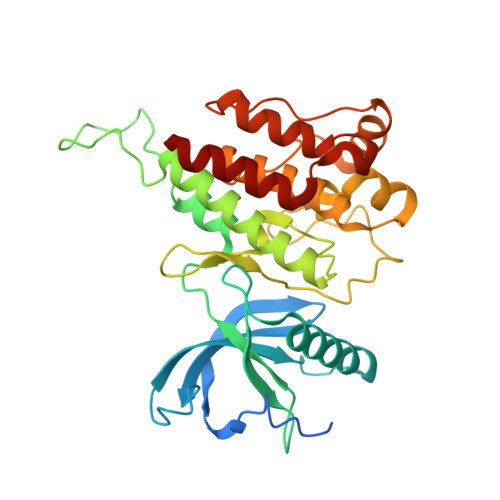DFG-out Mode of Inhibition by an Irreversible Type-1 Inhibitor Capable of Overcoming Gate-Keeper Mutations in FGF Receptors.
Huang, Z., Tan, L., Wang, H., Liu, Y., Blais, S., Deng, J., Neubert, T.A., Gray, N.S., Li, X., Mohammadi, M.(2015) ACS Chem Biol 10: 299-309
- PubMed: 25317566
- DOI: https://doi.org/10.1021/cb500674s
- Primary Citation of Related Structures:
4QQ5, 4QQJ, 4QQT, 4QRC - PubMed Abstract:
Drug-resistance acquisition through kinase gate-keeper mutations is a major hurdle in the clinic. Here, we determined the first crystal structures of the human FGFR4 kinase domain (FGFR4K) alone and complexed with ponatinib, a promiscuous type-2 (DFG-out) kinase inhibitor, and an oncogenic FGFR4K harboring the V550L gate-keeper mutation bound to FIIN-2, a new type-1 irreversible inhibitor. Remarkably, like ponatinib, FIIN-2 also binds in the DFG-out mode despite lacking a functional group necessary to occupy the pocket vacated upon the DFG-out flip. Structural analysis reveals that the covalent bond between FIIN-2 and a cysteine, uniquely present in the glycine-rich loop of FGFR kinases, facilitates the DFG-out conformation, which together with the internal flexibility of FIIN-2 enables FIIN-2 to avoid the steric clash with the gate-keeper mutation that causes the ponatinib resistance. The structural data provide a blueprint for the development of next generation anticancer inhibitors through combining the salient inhibitory mechanisms of ponatinib and FIIN-2.
Organizational Affiliation:
School of Pharmacy, Wenzhou Medical University , Wenzhou, Zhejiang 325035, China.
















